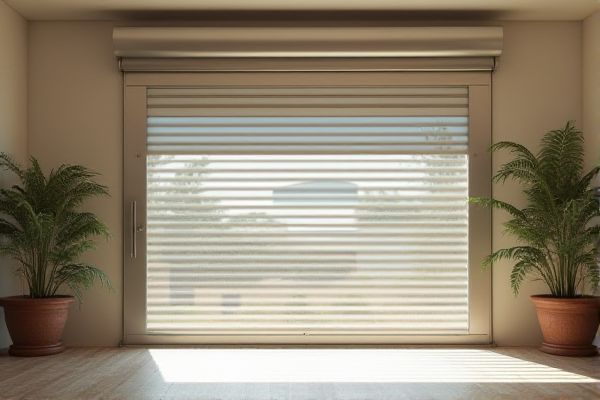
Roll-up doors save space by rolling into a compact coil above the opening, making them ideal for tight areas, while sectional doors consist of horizontal panels that slide upwards and rest parallel to the ceiling, offering enhanced insulation and aesthetic options. Discover which door type best suits Your needs by exploring the detailed comparison in the rest of this article.
Table of Comparison
| Feature | Roll-Up Doors | Sectional Doors |
|---|---|---|
| Design | Single curtain rolling up into a coil | Multiple horizontal panels hinged together |
| Space Efficiency | Minimal ceiling space required | Requires ceiling tracks for panel movement |
| Insulation | Generally less insulated | Better insulation options available |
| Security | Strong, compact, hard to breach | Robust with locking mechanisms, but panel joints may be vulnerable |
| Maintenance | Lower maintenance, fewer moving parts | Higher maintenance, hinges and tracks require upkeep |
| Installation Cost | Typically lower initial cost | Higher installation cost due to complex components |
| Typical Uses | Commercial and industrial warehouses, garages | Residential garages, commercial buildings |
| Operation | Manual or motorized roll-up | Manual or motorized sectional lift |
Introduction to Roll-Up Doors and Sectional Doors
Roll-up doors consist of horizontal slats that coil upward around a drum, ideal for saving space in tight areas, while sectional doors are made of panel segments that glide along tracks and fold overhead. Roll-up designs offer durability and security, commonly used in commercial settings, whereas sectional doors provide enhanced insulation and aesthetic versatility suitable for residential applications. Understanding these key differences helps you select the optimal door type for your building's functionality and style needs.
Key Differences Between Roll-Up and Sectional Doors
Roll-up doors feature a continuous curtain of horizontal slats that coil around a drum above the opening, maximizing space efficiency and durability in tight areas. Sectional doors consist of hinged panels that slide vertically along tracks and rest parallel to the ceiling when open, offering superior insulation and customization options. Your choice depends on factors like available space, insulation needs, and operational frequency to ensure optimal functionality and security.
Durability and Material Considerations
Roll-up doors typically feature corrosion-resistant steel slats, offering superior durability in harsh environments compared to sectional doors, which often use insulated steel panels that provide better thermal insulation but may be prone to denting. Sectional doors utilize reinforced materials such as aluminum or composite panels enhancing impact resistance, while roll-up doors excel in space-saving design and require minimal maintenance due to their robust construction. Selecting between roll-up and sectional doors depends on balancing material longevity, environmental exposure, and insulation requirements specific to commercial or industrial applications.
Space Requirements and Installation Needs
Roll-up doors require minimal space as they coil vertically into a compact drum above the opening, making them ideal for areas with limited headroom or ceiling space, while sectional doors need sufficient ceiling clearance for panels to slide along tracks. Installation of roll-up doors is typically quicker and less invasive due to their compact mechanism, whereas sectional doors demand more precise alignment and may involve additional structural support for the track system. Your choice should consider available installation space and structural conditions to ensure optimal functionality and ease of use.
Maintenance and Longevity Comparison
Roll-up doors typically require less maintenance due to their compact design and fewer moving parts, reducing the risk of mechanical issues over time. Sectional doors, while offering enhanced insulation and aesthetics, may need more frequent lubrication and alignment checks to ensure smooth operation and prolong their lifespan. Choosing the right door for your needs can impact ongoing maintenance costs and the overall longevity of Your installation.
Insulation and Energy Efficiency
Roll-up doors typically offer less insulation compared to sectional doors due to their thinner materials and tighter coil design, which can lead to greater heat transfer. Sectional doors often feature insulated panels with foam cores, significantly enhancing energy efficiency by maintaining consistent indoor temperatures. Choosing sectional doors can improve your building's insulation, reducing heating and cooling costs while increasing overall comfort.
Security Features and Access Control
Roll-up doors offer enhanced security with their robust steel slats and compact design, making them resistant to forced entry and ideal for high-security needs. Sectional doors provide advanced access control options, including integrated smart locks and personalized entry codes, allowing you to manage who enters your property with ease. Both door types include reinforced locking mechanisms, but roll-up doors excel in space-saving while sectional doors offer better insulation alongside security.
Cost Analysis and Budget Considerations
Roll-up doors generally offer a lower initial cost compared to sectional doors, making them a budget-friendly choice for tight financial plans. Sectional doors tend to have higher installation expenses due to their complex mechanisms but provide better insulation and durability, potentially reducing long-term energy costs. Evaluating your specific usage, maintenance needs, and energy efficiency goals will help you choose the most cost-effective door option.
Best Applications and Industry Suitability
Roll-up doors offer ideal solutions for warehouses and industrial facilities requiring space-saving, vertical operation, especially where ceiling clearance is limited. Sectional doors excel in commercial and residential applications that benefit from insulated panels and smooth sealing, providing enhanced energy efficiency and noise reduction. You should choose roll-up doors for high-traffic areas with limited space and sectional doors where thermal insulation and aesthetic integration are priorities.
Choosing the Right Door for Your Facility
Roll-up doors save space with their compact design, ideal for facilities with limited ceiling clearance or frequent vehicle access. Sectional doors provide better insulation and security, making them suitable for temperature-controlled environments and high-traffic warehouses. Assess your facility's space constraints, insulation needs, and usage frequency to determine which door type best supports your operational efficiency.
 homyna.com
homyna.com